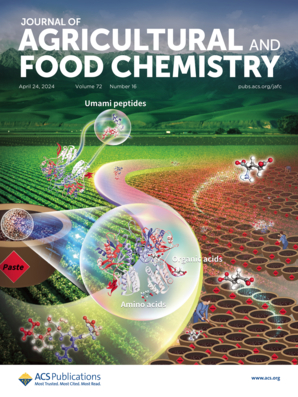Artemisinin Alleviates Alcohol-Induced Cardiotoxicity by Inhibiting Ferroptosis via the Nrf2/NQO1 Pathway In Vivo and In Vitro.
IF 5.7
1区 农林科学
Q1 AGRICULTURE, MULTIDISCIPLINARY
引用次数: 0
Abstract
The present study was designed to explore the protective effects of artemisinin on alcohol-induced cardiac injuries and its mechanisms. In H9c2 cells, cell viability, reactive oxygen species (ROS), labile iron pool (LIP), and mitochondrial membrane potential (MMP) were measured. In the mouse model of alcohol-induced cardiomyopathy, body weight and electrocardiogram (ECG) were recorded every day. Heart tissue creatine kinase (CK), lactic dehydrogenase (LDH), iron, glutathione (GSH), malondialdehyde (MDA), and histological examination were measured. Western blot assay was performed to evaluate the expression of ferroptosis-related proteins in vitro and in vivo. The results in vitro showed that cell viability was increased, ROS and LIP contents were decreased, and the level of MMP was increased in artemisinin-treated H9c2 cells. Tissues CK, LDH, and GSH were improved after being treated with artemisinin. The ferroptosis biomarkers, including MDA and tissue iron, were attenuated after artemisinin treatment. Artemisinin protected the heart from alcohol damage by ECG and histological examination. Additionally, artemisinin down-regulated the expression of TfR and P53 and up-regulated Nrf2, HO-1, NQO1, and GPX4 expressions in vitro and in vivo. The results showed that both Fer-1 and artemisinin abolished ferroptosis. The data presented here showed that artemisinin had the potential to protect alcohol-induced cardiotoxicity through the inhibition of Nrf2/NQO1-dependent ferroptosis.在体内和体外研究中,青蒿素通过Nrf2/NQO1途径抑制铁下沉减轻酒精诱导的心脏毒性。
本研究旨在探讨青蒿素对酒精性心脏损伤的保护作用及其机制。在H9c2细胞中,测定细胞活力、活性氧(ROS)、不稳定铁池(LIP)和线粒体膜电位(MMP)。在酒精性心肌病小鼠模型中,每天记录体重和心电图。检测心脏组织肌酸激酶(CK)、乳酸脱氢酶(LDH)、铁、谷胱甘肽(GSH)、丙二醛(MDA)及组织学检查。Western blot法检测小鼠体内和体外凋亡相关蛋白的表达。体外实验结果显示,经青蒿素处理的H9c2细胞活性提高,ROS和LIP含量降低,MMP水平升高。经青蒿素处理后,组织CK、LDH、GSH均有改善。铁下垂生物标志物,包括MDA和组织铁,在青蒿素治疗后减弱。经心电图和组织学检查,青蒿素可保护心脏免受酒精损害。此外,青蒿素在体外和体内下调TfR和P53的表达,上调Nrf2、HO-1、NQO1和GPX4的表达。结果表明,铁-1和青蒿素均能消除铁下垂。本研究的数据表明,青蒿素有可能通过抑制Nrf2/ nqo1依赖性铁凋亡来保护酒精诱导的心脏毒性。
本文章由计算机程序翻译,如有差异,请以英文原文为准。
求助全文
约1分钟内获得全文
求助全文
来源期刊
CiteScore
9.90
自引率
8.20%
发文量
1375
审稿时长
2.3 months
期刊介绍:
The Journal of Agricultural and Food Chemistry publishes high-quality, cutting edge original research representing complete studies and research advances dealing with the chemistry and biochemistry of agriculture and food. The Journal also encourages papers with chemistry and/or biochemistry as a major component combined with biological/sensory/nutritional/toxicological evaluation related to agriculture and/or food.

 求助内容:
求助内容: 应助结果提醒方式:
应助结果提醒方式:


